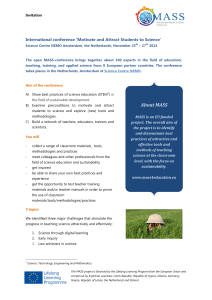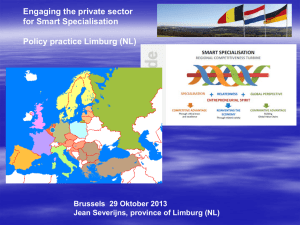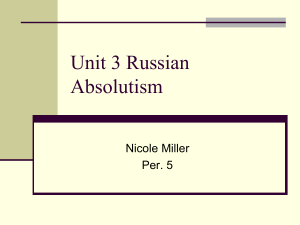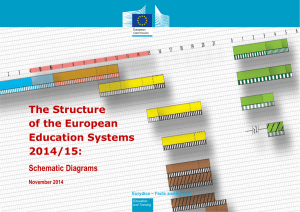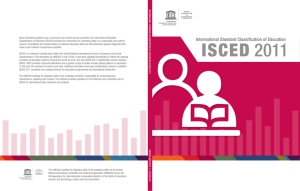Netherlands (291 kB)
advertisement
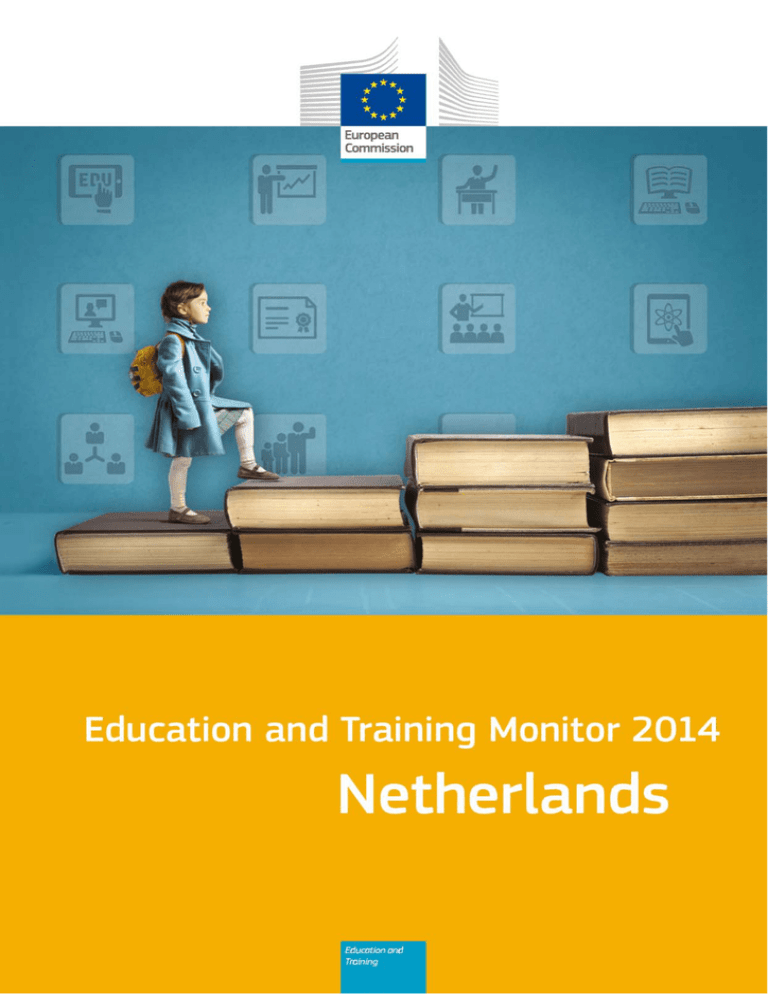
NETHERLANDS Netherlands Europe 2020 headline target 1. Early leavers from education and training (age 18-24) 2. Tertiary educational attainment (age 30-34) ET 2020 Benchmarks 3. Early childhood education and care (4-years-old until the starting age of compulsory education) 4. Basic skills Reading Low achievers (15 year-olds; Mathematics Level 1 or low er in PISA study) Science Initial vocational training (IVET) 5. Learning mobility Higher Education a. Students participating in Leonardo da Vinci programmes as a share of vocational students at ISCED 3 b. Erasmus inbound students as % of student population in host country c. Inbound international degree mobile students as % of student population in the host country 2010 2013 10.0% 9.2% 41.4% 43.1% Trend 1. Key indicators and benchmarks 2010 2013 ▼ 13.9% 12.0% ▲ 33.6% 36.9% Europe 2020 target / EU28 average Benchmark EU target: 10% National target: <8% EU target: 40% National target: >40% 99.5% 09 99.6% 12 = 92.1% 09 93.9% 12 95% 14.3% 09 14.0% 12 ▼ 19.7% 09 17.8% 12 15% 13.4% 09 14.8% 12 ▲ 22.3% 09 22.1% 12 15% 13.2% 09 13.1% 12 = 17.8% 09 16.6% 12 15% 0.7% 1.0% 12 ▲ 0.6% 0.7% 12 - 1.2% 12 : - 1.2% 12 7.2% 12 ▲ 6.0% 6.9% 12 4.9% 11 6. Employment rate of ISCED 3-6 recent graduates (age 20ISCED 3-4 92.6% 87.1% ▼ 77.4% 75.5% 89.7% 81.9% ▼ 72.1% 69.5% ISCED 5-6 94.8% 91.3% ▼ 82.7% 80.9% 16.6% 17.4% ▲ 9.1% 10.5% 5.8% 5.8% 12 = 5.5% 5.3% € 7,213 € 7,188 11 ▼ €6,063.74 e €6,297.16 11, e € 8,965 € 9,153 11 ▲ €7,022.35 e €6,650.87 11, e € 13,218 € 13,309 11 ▲ €9,764.30 e €9,474.80 11, e 34) having left education 1-3 years before reference year 7. Adult participation in lifelong learning (age 25-64) 82% b 15% Other ET 2020 Indicators a. General government expenditure on education (% of GDP) b. Annual expenditure on ISCED 1-2 8. Investment in education and training public and private ISCED 3-4 educational institutions per pupil/student in € PPS ISCED 5-6 83.2% 07 85.6% 11 ▲ 60.7% 07 64.7% 11 40.0% 09 30.0% 12 ▼ 25.0% 09 26.0% 12 : 6.7% 12 : : 16.9% 12, EU17 : 41.5% 12 : : 33.2% 12, EU13 : 42.0% : : 42.3% a, EU18 : 65.7% 11 : : 43.5% 11, EU13 75.9% 73.6% 12 ▼ 60.6% 63.0% 11 : 11.7% 12 : : 19.9% 12, EU17 : 59.6% 12 : : 43.3% 12, EU17 : 13.2% 12 : : 23.6% 12, EU17 : 56.4% 12 : : 40.9% 12, EU17 High qualification : +15.6% : : +12.4% Medium qualification : -2.6% : : +2.1% Low qualification : -8.6% : : -13.2% 45.9% 46.2% ▲ : : : 93.2% : : 84.6% EU19 67.0% 69.5% 50.1% 50.4% 12 Digital competences Problem solving in technology rich environments 9. Transversal competences a. Pupils in grade 4 (ISCED 1) using computers at school Entrepreneurial competences Foreign language skills Literacy b. Individuals aged 16-74 with high computer skills 2 c. Low achievers (no or insuff. computer experience) 3 d. High achievers (PIAAC level 2 and above) e. Individuals aged 18-64 who believe to have the required skills and knowledge to start a business f. ISCED 2 students at proficiency level B1 or higher in first foreign language4 g. ISCED 2 students learning two or more foreign languages Low achievers (< PIAAC proficiency level 2) High achievers (PIAAC proficiency level 3 and >) 10. Basic skills of adults Low achievers Numeracy (< PIAAC proficiency level 2) High achievers (PIAAC proficiency level 3 and >) 11. Skills for future labour market Projected change in employment 2010-2020 in % 12. Teachers 12 a. Teachers aged >50 teaching in public and private at ISCED 2-3 - as % of total teachers teaching in ISCED 2-3 5 b. Percentage of teachers who undertook some professional development activities in the previous 12 months 13. Vocational Percentage of vocational students at ISCED 3 education and training 12 12 ▲ 12 Source: Cedefop: 11 / EAC: 5ab / European Survey on Language Competences (ESLC): 9f / Eurostat (COFOG): 8a / Eurostat (ISS): 9b / Eurostat (LFS): 1, 2, 6, 7 / Eurostat (UOE): 3, 5, 8b, 9g, 12a, 13 / Global Entrepreneurship Monitor: 9e / IEA TIMSS: 9a / OECD (PIAAC): 9cd, 10 / OECD (PISA): 4 / OECD (TALIS): 12b Notes: 07 =2007, 08 =2008, 09 =2009, 10 =2010, 11 =2011, 12 =2012, a= unweighted average, b= break, e= estimate, p= provisional. = For 13% of population in the country the information about mobility status is unknown, 2= having carried out 5-6 specific computer related activities. Caution is advised when interpreting comparability over time, due to developments in the implementation of questions related to computer skills, 3= results cover people who have no computer experience or failed the ICT test, 4= average of skills tested in reading, listening, writing, 5= in some Member States, ISCED 3 includes level 4 (CZ, EE, ES, IE, NL, FI, UK), while in others (IT, LU, NL) only public institutions figures are reported. 1 2 NETHERLANDS Figure: Position in relation to highest (outer ring) and lowest performers (centre) Source: DG Education and Culture calculations, based on data from Eurostat (LFS 2013 and UOE 2012) and OECD (PISA 2012). Note: all scores are set between a maximum (the highest performers visualised by the outer ring) and a minimum (the lowest performers visualised by the centre of the chart). 2. Main challenges The Netherlands has a well–functioning educational system and has already reached its national target for tertiary attainment set for 2020 and is approaching that for early school leaving. Adults' basic skills are significantly above the EU average and the employment rate of recent graduates is high both for secondary education as well as tertiary graduates. Challenges however remain in the following areas: (i) a shortage of qualified or well-performing teachers in secondary education for the subjects languages, maths and science; (ii) improving labour market relevance of secondary vocational education training (Middelbaar Beroeps Onderwijs); (iii) protecting public expenditure for education and improve quality. The 2014 national reform programme acknowledged these challenges and points to a number of measures that have been taken aimed at improving the quality of education across educational levels. The 2014 European Semester country-specific recommendation (CSR) relevant to education and training focused on protecting expenditure in areas directly relevant to growth such as education, innovation and research. 3. Improving resource efficiency and effectiveness 3.1 Investment in education General government expenditure on education as a share of GDP remained stable between 2010 and 2012 at 5.8 % of GDP, which is slightly above the EU average (5.3%)1. However, it dropped as a percentage of total government expenditure, from high over 19% in 2005 to just above 17% in 20122. Annual expenditure per student in public and private educational institutions for all ISCED categories is above the EU average. In 2013, the government added EUR 650 million to the lump sum contribution for schools. For 2015 and on, an additional EUR 600 million will be allocated to the education and research sectors. The extra funding is intended to be used in areas such as more and better activities in the classroom, preventing students repeating classes, appropriate teaching, and hands-on teaching and technical education in vocational education and the internationalisation of higher education. 3 3.2 A focus on teachers According to the 2013 OECD Teaching and Learning International Survey (TALIS)4 Dutch teachers display a professional attitude and are satisfied with their jobs and feel reasonably valued in their work. In the Netherlands, there is systematic feedback and appraisal: only 2% of teachers (according to their school leaders) 1 2 3 4 SWD(2014) 420 final of 2.6.2014: and see also OCW (2012), Onderzoek naar de financiële positie van schoolbesturen in po en vo on the financial situation of schools in primary and secondary education. Statistics Netherlands (CBS)Stability Programme, data provided by the Ministry of Finance Statistics Netherlands (CBS) Stability Programme, data provided by the Ministry of Finance NRP 2014 page 42 and Parliamentary Documents 2013-2014, 33 750 VIII, no. 95 and http://www.rijksoverheid.nl/ministeries/ocw/nieuws/2014/07/14/5-miljoen-voor-internationaal-beursprogramma.html http://www.oecd.org/edu/school/talis.htm 3 NETHERLANDS are never formally appraised and 6% have never received feedback in their current school (compared to an EU average of 16% and 17%, respectively). Moreover, the proportion of teachers who have undertaken professional development activities in the last 12 months is high (93% versus an EU average of 85%). Teachers perceive their status as relatively high: 40% think their profession is valued in society (versus an EU average of 18%). The proportion of teachers taking part in a formal induction programme during their first regular employment (46%) is close to the EU average. Teachers in the Netherlands spend 74% of their lesson time on actual teaching and learning, which is slightly below the average in TALIS countries (79%). They report spending more time on keeping order in the classroom (16%) and on administrative tasks (10%) than the TALIS average5. The survey also highlights a number of important challenges for the Netherlands relating to attracting the best candidates into the teaching profession and motivating students. A serious challenge is the aging teaching population and the shortage of qualified and well-performing teachers in some subjects (mostly languages, maths and science). 70% of Dutch school leaders report that quality of education is negatively affected by shortages of qualified and/or well-performing teachers and teachers with competences in teaching students with special needs. In terms of self-efficacy, the proportion of teachers who feel they can motivate students who show low interest in school work is lower than the EU average (62% compared to 71%). Only 20% of Dutch teachers state that they give different work to the students with learning difficulties and/or to those who can advance faster. The Dutch Education Advisory Board (Onderwijsraad)6 concluded in 2013 that the policy of recent years was focused too much on the quantitative shortage of teachers. Only in recent years, policy had begun to concentrate more on quality. The recommendations presented in their report were about: (i) making more use of better recruitment methods and selection for future students in teacher education; (ii) increasing the professional standard by more in-service training and aiming at the achievement of a Master's degree for all new pre-university teachers; (iii) developing professional and educational school leadership as an essential element for an attractive working environment; (iv) organizing better regional coordination for the recruitment of teachers and other support staff. In addition, according to the Dutch Inspectorate of Education, teacher training and development could be improved to better meet the individual needs of new teachers and teachers in need of developing complex skills, such as differentiated teaching for diversity. The government has launched a series of activities7 aimed at raising teaching standards and the professional qualifications of teaching staff. As part of this, teachers are increasingly being encouraged to learn from their colleagues through a process of peer reviews. In parallel, teachers are progressively being required to join a national teacher registry, run by a body formed by teacher organizations to monitor professional qualifications. Candidate teachers are being encouraged to study for a Master's degree, and the responsibilities of the government school inspectorate are extended to include the assessment of teachers' skills. Other strategies include adapting content and teaching methods to meet the needs of specific student groups, including both those with learning difficulties and high achievers.8 4. Increasing employability 4.1 Work-based learning, apprenticeships and adult learning Recently graduated secondary students account for 69.5% of initial vocational education and training (VET) students which is higher than the EU average (50.4% in 2012). VET graduates in the Netherlands are more likely to go on to further education and training than in the EU. The employment rate of recently graduated upper secondary graduates was 81.9% in 2013 compared to a European average of 69.5%9. Foreign-born are shown to be one of the subgroups worst affected by the economic recession (more than 20%) in terms of retaining employment or finding employment while the native born show a decrease of less than 5% (2008-2013) 10. The participation of adults in lifelong learning in the Netherlands (17.4% in 2013) is nearly twice that of the current EU average. The Netherlands also scores well in the terms of the percentage of non-formal education and training which is job-related (89.4% versus 81.4% in the EU in 2011)11. In 2010, 79% of enterprises provided vocational training to their staff, compared to an EU average of 66%12. In addition, the participation rate of lowskilled adults in job-related training is one of the highest among EU countries. 5 6 7 8 9 10 11 12 http://www.talis2013.nl/cms/userfiles/files/TALIS-2013-country-note-Netherlands.pdf https://www.onderwijsraad.nl/publicaties/2013/een-smalle-kijk-op-onderwijskwaliteit/item7042 http://www.delerarenagenda.nl/ http://www.pearsonfoundation.org/oecd/netherlands.html http://ec.europa.eu/education/dashboard/employment/employment_en.htm ec.europa.eu/education/monitor: additional contextual indicators. On the way to 2020 data for vocational training and education http://www.cedefop.europa.eu/EN/publications/22388.aspx Eurostat, CVTS 2011 4 NETHERLANDS The Survey of Adult Skills (PIAAC)13 shows that literacy and numeracy skills of Dutch adults (aged 16-65) are significantly above the EU average. A large proportion of the population (more than 40%) displays high problemsolving skills in technology rich (ICT) environments. The youngest generation (aged 16-24) scores better than the overall population in literacy (by 10 points, i.e. equivalent to skills usually acquired with one to two years of education). On the one hand, the proportion of low-skilled adults is comparatively low – below 12% for literacy and around 13% for numeracy compared with 19% and 24% respectively in the EU. On the other hand, the gap between native and foreign-born adults in educational level as well as in numeracy and literacy is large compared to the EU average (close to 50 points, i.e. equivalent to skills usually acquired with 7 years of education). The action plan "Focus op Vakmanschap 2011-2015" aims to make the Vocational Education and Training (VET) institutions more innovative, smaller and better organised to provide education in the region, so that more young people can opt for vocational training. In particular to tune VET better to the regional labour market needs, in 2014 the government reduced four year courses to three years, increased classroom hours, improves the transition to higher professional education and improves the quality of this level. In addition, a new grant scheme aims to give incentives to employers to provide work-study placements. Talented young people are given more opportunities to develop their creativity, knowledge and skills and entrepreneurial high-level skills. In addition an agreement was reached on July 2014, which provides more opportunities for personal development opportunities and growth opportunities for VET teachers, better quality of internships, more attention to talent and fewer dropouts in vocational education14. In July 2014 the Minister of Education proposed a new regulation to merge the different centres of expertise into one organization, the SBB15. Currently the main challenges for the management boards of the VET schools are: implementing the changes in budget allocations, shortening the duration of the educational/teaching time, making the necessary adaptations to meet the qualification structure to be realised for 2016. European Social Fund (ESF) funded activities in the period 2014-20 will focus on increasing the employment rate of adults and making best use of the labour force. The ESF will support the (re)-training of older workers, the work-to-work tracks and individual coaching run by the Dutch municipalities. Besides also supporting enterprises and employees, the remainder of the ESF investments will go on creating work environments that enable older workers to stay active longer. The Netherlands submitted a Youth Guarantee Implementation Plan on 7 April 2014. The approach is aimed at preventing youth unemployment by offering high-quality education that matches the needs of today’s labour market. It also strongly focuses on reducing early school leaving on the one hand and tackling youth unemployment at the regional level on the other hand. 4.2 Modernising and internationalising higher education The tertiary education attainment rate, for which the 2020 national target is at least 40%, reached 43.1% in 2013. The increase has been partly achieved by encouraging students to complete their studies more quickly. The employment rate of recent tertiary graduates 91.3% in 2013 is very high16. The current partly grant-based system for students in tertiary education will change from September 201517. Students will have to fully finance their studies, but may take low-interest loans from the government. Repayment of these loans will depend on the students’ income after graduation. The loan system includes special measures for students from low income families. Savings gained from this measure are to be re-invested, particularly in the quality of education, although the details of how this will be done are not yet known. The impact on tertiary enrolment and on the levels attained at graduation should be closely monitored, especially for students from underprivileged backgrounds. It will also be important to communicate the benefits of further study to (loan-averse) prospective18. 13 14 15 16 17 18 Volume I of the Education and Training Monitor (chapter 6) Kamer brieven over toekomst gericht Middelbaar beroepsonderwijs, 2 July 2014 and 11 July 2014 SBB: Cooperation VET and business sector: Samenwerking Beroepsonderwijs Bedrijfsleven People aged 20-34 who have left education between one and three years before the reference year. http://www.tweedekamer.nl/kamerstukken/dossiers/studiefinanciering_sociaal_leenstelsel.jsp SWD(2014) 420 final of 2.6.2014 5 NETHERLANDS A number of measures are aimed at reducing drop-outs19 by introducing specific admission requirements for universities. From 2014, students have to register their study choice before 1 May. This entitles them for studyadvice and the right to be accepted for another study choice if this is preferred. 4.3 Transversal competences, skills relevance and learning mobility, new ways of teaching and new technologies ICT skills levels are far better than the EU average and Dutch citizens' confidence in entrepreneurship competences seems to be on a par with the European average. According to the European Centre for the Development of Vocational Training (CEDEFOP), employment in high qualification jobs between up to 2020 is forecast to increase more than the EU average. International surveys20 indicate excellent skills in the first foreign language, English. More attention however may be paid, to subjects such as history, economics, philosophy and culture and crosscurricular ‘advanced skills’ (skills such as problem-solving, information and communications technology skills).21 The Netherlands has a national ICT strategy in schools covering areas such as e-government, infrastructure and broadband connectivity, ICT Security, e-learning and ICT. At the same time, the number of technology graduates in the Netherlands is not increasing fast enough. Analyses show that 30 000 additional technology graduates are needed each year to meet the growing demand.22 In response to these challenges, the government announced its National Technology Pact 202023, requiring commitments from both public and private stakeholders. A coordinating group composed of regional representatives, central government, employers, workers, the top sectors and the education community monitors the implementation of the strategy24. Effective implementation of the strategy will be crucial to preserving and enhancing the innovative capacity of high-tech companies in the Netherlands. Nevertheless, despite the favourable framework conditions, maintaining and improving its competitive position in the future will be a challenge. Further efforts to reduce skill shortages, especially in engineering and the technology-related professions, are needed to increase the competitiveness of the Dutch economy.25 Already in 2011, the Netherlands developed and implemented a National Qualifications Framework (NLQF), referenced it to the European Qualifications Framework for lifelong learning (EQF). Qualifications are classified at the appropriate level in the NLQF and, thus, are aligned to an appropriate EQF level. Not only does the NLQF include the traditional qualifications regulated by different parts of government, but it also strengthens the value of the many other qualifications that have significance and ‘qualifying’ power in the labour market. New VET qualifications were adopted in January 2014 and included in the NLQF. The Netherlands is in the process of regulating the relevant EQF level on new certificates and diplomas. 5. Tackling inequalities 5.1 Starting strong: improving early childhood education and care and tackling early school leaving Early school leaving fell from 10% in 2010 to 9.2% in 2013 bringing closer to the 2020 national target of less than 8%. Participation in early childhood education is almost universal, which is relevant to preventing early school leaving. The Netherlands is one of the EU countries with explicit strategies to reduce the number of early school leavers. Since 2002 the continued support for the "Drive to reduce drop-out rates", and the recent multi-annual voluntary agreements (2012-15) aim to reduce the percentage of early school leavers. The strategy provides for a longterm perspective, systematic efforts and resources, an integrated approach focussing on prevention, and tight organisation at regional level. The Dutch have an accurate record-keeping system which is an important tool in implementing the strategy. All the various links in the chain – education, the labour market, and care – provide a good basis for preventing young people dropping out of school. 19 20 21 22 23 24 25 http://www.rijksoverheid.nl/onderwerpen/hoger-onderwijs/studiekeuze-en-toelating European Survey on Language Competences, ESLC Een smalle kijk op onderwijs-kwaliteit: report of the ‘Education Advisory Council’ 2013. Research Centre for Education and the Labour Market (ROA) Nationaal Techniekpact 2020. www.techniekpact.nl. Report on MS Competitiveness - country fiches: http://ec.europa.eu/enterprise/policies/industrial-competitiveness/monitoring-memberstates/index_en.htm 6 NETHERLANDS 5.2 Basic skills of students The results of the OECD PISA 2012 survey show in general relatively good scores compared to the EU average. The competence level for mathematics has however decreased somewhat since 2009. Positive outcomes are the relatively high performance of Dutch students in the lower range of international assessment tests. Early tracking in secondary education may accentuate differences between young people from different social (and migrant) backgrounds26. The government's aim is to keep opportunities open for mobility between different types of secondary schools (including upward mobility)27. From the higher range of international assessment tests, it becomes clear that students are not challenged enough to reach for excellence and in response the Government has launched a strategy for "ambitious education"28. 26 27 28 SWD(2014) 420 final of 2.6.2014 and School tracking systems, which allot students to certain school types according to their ability, seek to improve efficiency in education by tailoring curricula to students’ needs. Yet, early tracking bears the risk of misallocating students, as information about their full academic potential may be incomplete at the time of tracking. http://www.onderwijsinspectie.nl/binaries/content/assets/Onderwijsverslagen/2014/onderwijsverslag-2012-2013.pdf http://www.trendsinbeeld.minocw.nl/vervolg.php?h_id=5&s_id=20&v_id=52&d_id=19&titel=Sectorakkoorden 7



